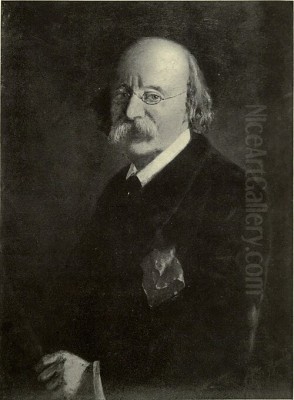
John Anster Fitzgerald stands as one of the most intriguing and distinctive figures in Victorian art. Known affectionately and sometimes enigmatically as "Fairy Fitzgerald," he carved a unique niche for himself by specializing in fantastical scenes populated by fairies, goblins, demons, and dream-like apparitions. Working primarily between the 1840s and the early 1900s, Fitzgerald captured the Victorian era's fascination with the unseen world, blending whimsical charm with an often unsettling, darker undercurrent. Though details of his life remain somewhat obscure, his vibrant, intricate, and highly imaginative paintings secure his place as a master of fantasy art.
Early Life and Artistic Formation
John Anster Fitzgerald was born in Lambeth, London, around 1819, although his exact birth year has been subject to some debate. He was the son of William Thomas Fitzgerald, a minor poet associated with the literary circles of his time, which perhaps provided an early exposure to imaginative themes. Despite this background, Fitzgerald appears to have received little formal art training. He is largely considered a self-taught artist, developing his distinctive style through personal study and practice rather than academic instruction.
His artistic career began to gain public notice in the mid-1840s. Fitzgerald first exhibited at the prestigious Royal Academy of Arts in London in 1845. This marked the beginning of a long, though somewhat peripheral, engagement with the established art institutions of the day. Over the following decades, he would continue to exhibit his works not only at the Royal Academy but also at the British Institution, the Society of British Artists (later the Royal Society of British Artists), and the Royal Watercolour Society, demonstrating proficiency in both oil and watercolour mediums.
Despite exhibiting regularly, Fitzgerald never seemed to fully integrate into the mainstream London art world. He maintained a degree of separation, cultivating a unique artistic voice that set him apart from the dominant trends of Realism, Pre-Raphaelitism, or Academic history painting that characterized much of the Victorian era. His path was one of individual vision rather than adherence to a particular school or movement.
The Victorian Fascination with Fairyland
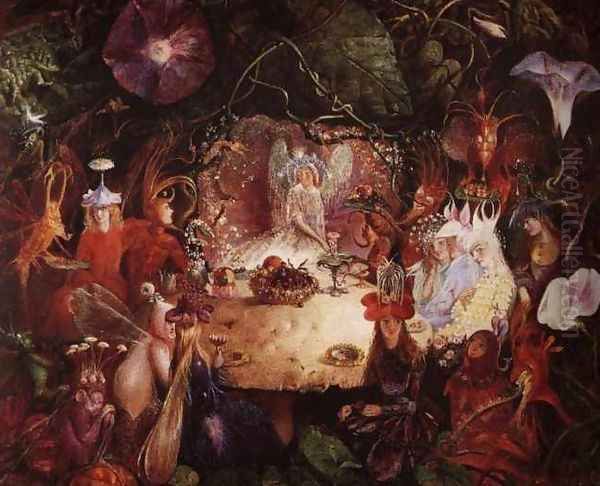
To understand Fitzgerald's art, it is essential to place it within the context of the Victorian era's deep fascination with fairies and the supernatural. This period saw a resurgence of interest in folklore, mythology, and the spiritual world, partly as a reaction against the rapid industrialization and scientific rationalism transforming society. Fairies, often drawn from British folk traditions and popularized by literature, particularly Shakespeare's A Midsummer Night's Dream, became potent symbols of nature, magic, escapism, and the hidden realms beyond human perception.
Painters like Richard Dadd, whose own life took a tragic turn, explored fairy themes with intense, almost hallucinatory detail before Fitzgerald gained prominence. Later artists such as Joseph Noel Paton in Scotland also created elaborate fairy canvases. Fitzgerald, however, brought a particular intensity and often a darker, more complex psychological dimension to the genre. His fairies were not always the benevolent, gossamer-winged sprites of popular imagination; they could be mischievous, grotesque, or even menacing.
This interest also coincided with the rise of spiritualism and a widespread curiosity about dreams, nightmares, and altered states of consciousness. The era saw increased use of substances like laudanum (an opium tincture), and some critics have speculated that the vivid, sometimes nightmarish quality of Fitzgerald's work might reflect personal experiences or observations related to opium dens, though this remains conjectural. His art certainly delves into the territory of the subconscious, exploring themes of temptation, fear, and the bizarre logic of dreams.
Fitzgerald's Distinctive Artistic Style
John Anster Fitzgerald's style is immediately recognizable. His paintings are typically characterized by intricate detail, vibrant, jewel-like colours, and compositions teeming with miniature figures and fantastical elements. He often employed strong contrasts between light and shadow, creating dramatic, theatrical effects that enhance the otherworldly atmosphere of his scenes. His palette frequently favoured rich reds, blues, purples, and greens, applied with a meticulous technique that gives his surfaces a luminous quality.
His subject matter consistently revolved around the fantastical. Fairies, elves, goblins, and demonic creatures populate his canvases, often interacting with humans, animals, or elements of the natural world in unexpected ways. Birds, mice, insects, and plants are rendered with careful observation but frequently incorporated into bizarre or symbolic narratives. His compositions can range from idyllic fairy revels to chaotic, nightmarish visions reminiscent of earlier masters of fantasy.
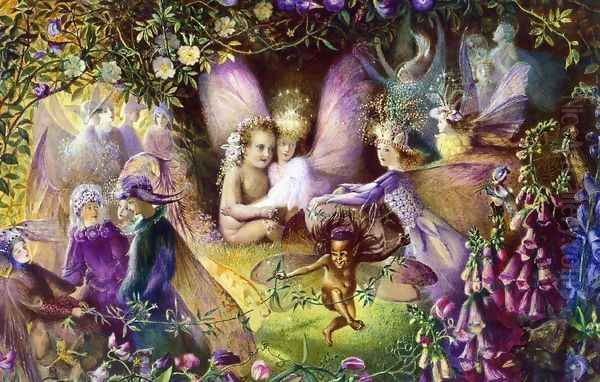
Indeed, Fitzgerald's work often draws comparisons to the Northern Renaissance painters Hieronymus Bosch and Pieter Bruegel the Elder. Like Bosch, Fitzgerald depicted grotesque creatures and explored themes of sin and temptation, albeit filtered through a Victorian sensibility. Like Bruegel, he often filled his canvases with numerous small figures engaged in various activities, creating complex, multi-layered scenes. However, Fitzgerald's vision remained distinctly his own, infused with the specific anxieties and preoccupations of his time.
Key Works and Recurring Themes
Fitzgerald produced a significant body of work, much of it centered on fairy subjects, dreams, and narrative scenes often involving animals, particularly birds. Several paintings stand out as representative of his unique talent.
Fairy Banquet: This title encompasses several works depicting elaborate feasts enjoyed by fairy creatures. These scenes are typically set in lush natural environments, often at twilight or night. They showcase Fitzgerald's skill in rendering minute details – tiny goblets, intricate costumes, expressive faces on minuscule figures – and his ability to create a sense of magical abundance, sometimes tinged with a hint of decadence or hidden danger.
Titania and the Changeling: Drawing inspiration from Shakespeare's A Midsummer Night's Dream, Fitzgerald painted scenes related to the play, though often with his own imaginative additions. Works possibly related to Titania, the fairy queen, or other Shakespearean fairy lore demonstrate his engagement with literary sources while allowing him ample room for fantastical invention.
The Stuff That Dreams Are Made Of: This painting, and others like it, directly addresses the theme of dreams and nightmares. Often depicting a sleeping figure surrounded by swirling, phantasmagoric visions – both beautiful and terrifying – these works are among Fitzgerald's most psychologically complex. They visualize the subconscious mind as a battleground or playground for bizarre and often demonic entities, reflecting Victorian anxieties about the hidden self.
The Captive Robin and related works: Fitzgerald frequently painted scenes involving birds, sometimes interacting with fairies or goblins. The Captive Robin series, along with paintings like Who Killed Cock Robin? and Fairy Lovers in a Bird's Nest, uses birds symbolically. These works can evoke themes of innocence, captivity, nature's vulnerability, or the sometimes cruel relationship between the fairy world and the natural world. The level of detail in the depiction of the birds and their nests is remarkable.
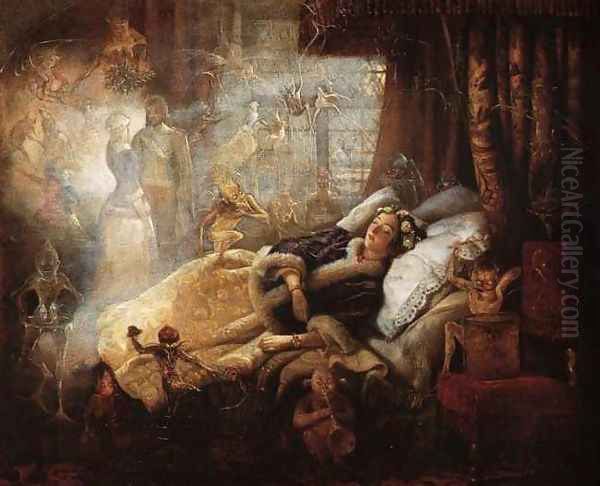
The Intruder: This work, featuring fairies interacting with fungi, touches upon the Victorian interest in the natural world's stranger corners. Mushrooms and toadstools, often associated with fairy rings and folklore, appear frequently in his work, adding to the uncanny atmosphere. The Intruder highlights the tension between the natural and the supernatural, a recurring motif in his art.
His illustrations for the Illustrated London News, particularly a series of Christmas fairy pictures created in the late 1850s, brought his work to a wider audience. These images, while perhaps more conventionally charming than some of his darker easel paintings, still bear his hallmark style of intricate detail and imaginative flair.
Exhibition History and Contemporary Recognition
From his debut in 1845 until the early 1900s, Fitzgerald was a consistent presence at London's major art exhibitions. He showed numerous works at the Royal Academy, the British Institution, the Society of British Artists, and the Royal Watercolour Society. This indicates that, despite his unique subject matter, his technical skill was recognized and his work found a place within the established exhibition system.
However, he does not seem to have achieved the same level of fame or critical acclaim as some of his contemporaries. While artists like the Pre-Raphaelites – Dante Gabriel Rossetti, John Everett Millais, and William Holman Hunt – dominated critical discourse with their revolutionary approach to realism and symbolism, Fitzgerald occupied a more specialized niche. His work might have been seen as less serious or relevant to the major artistic debates of the day compared to the historical, religious, or socially conscious themes tackled by others.
Painters like William Powell Frith captured the bustling panorama of modern Victorian life, while Sir Edwin Landseer achieved immense popularity with his sentimental and dramatic animal paintings. Gustave Doré, a French artist widely known in Britain, produced powerful, often dark illustrations for literary classics, sharing some thematic ground with Fitzgerald but working on a grander, more epic scale. Fitzgerald's focus remained intensely personal and fantastical, appealing perhaps to a more specific taste for the whimsical and the weird.
Personal Life and Character
Information about John Anster Fitzgerald's personal life is relatively scarce, contributing to the air of mystery that surrounds him. He married Mary Ann Barratt in 1849, and they had several children. He lived and worked in London for most of his life, eventually settling in the Savage Club, a bohemian gentlemen's club frequented by artists, writers, and actors.

Contemporary accounts and later biographical notes suggest he was a somewhat retiring figure, not deeply involved in the social machinations of the London art scene. Descriptions paint him as quiet and perhaps eccentric. His membership in the Savage Club suggests a sociable side, but within a specific, less formal environment than the elite art academies or societies. He seems to have preferred the company of fellow creatives in a relaxed setting over the competitive atmosphere of the mainstream art world.
The recurring speculation about his familiarity with opium dens, fueled by the hallucinatory quality of some of his paintings, remains unproven. While his art certainly explores altered states and dream-like visions, this could equally stem from a powerful imagination, an interest in folklore and Gothic literature, or simply a desire to explore the boundaries of visual representation. His life, like his art, seems to contain hidden depths and unanswered questions.
Fitzgerald and His Contemporaries
Placing Fitzgerald within the broader landscape of Victorian art highlights his unique position. While fairy painting was a recognized genre, Fitzgerald pushed its boundaries beyond mere illustration or whimsical decoration. Unlike Richard Dadd, whose intricate fairy paintings were created under tragic circumstances of mental illness, Fitzgerald's output was sustained over a long career, suggesting a consistent artistic preoccupation rather than a singular obsession.
Compared to the Pre-Raphaelites, Fitzgerald shared an interest in detail and vibrant colour, but his subject matter and style were vastly different. While Rossetti explored medieval romance and sensual symbolism, and Millais moved from detailed realism to broader social narratives, Fitzgerald remained committed to his inner world of fantasy. He lacked the moralizing or didactic intent often found in Pre-Raphaelite or other mainstream Victorian art.
His work can be seen as a precursor to later fantasy illustrators like Arthur Rackham, whose illustrations for fairy tales and fantasy literature in the early 20th century owe a debt to the Victorian tradition of fairy painting, including Fitzgerald's contributions. Fitzgerald's influence might be less direct than that of major figures like J.M.W. Turner, whose atmospheric landscapes revolutionized painting, or William Blake, whose visionary art explored spiritual and mythological themes decades earlier. Yet, Fitzgerald's dedication to the fantastical provided a vital thread in the tapestry of imaginative art. Other contemporaries like Arthur Hughes, associated with the Pre-Raphaelites but also known for his gentle, poetic paintings, sometimes touched on fairy themes, but without Fitzgerald's characteristic intensity or darkness. Daniel Maclise, an earlier Victorian artist, also depicted fairy scenes, notably his large The Marriage of Aoife and Strongbow, but often integrated them into historical or literary contexts.
Legacy and Influence
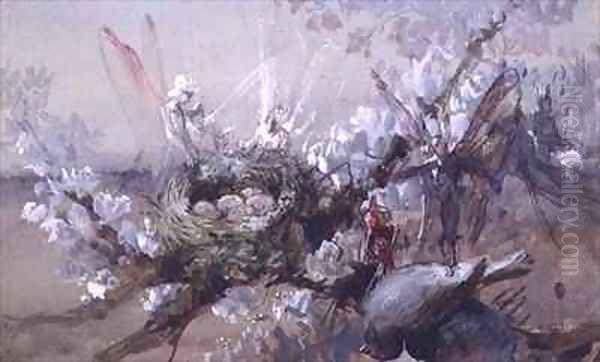
John Anster Fitzgerald passed away in 1906. For a time after his death, his work, like much Victorian fairy painting, fell out of fashion as modern art movements gained ascendancy. However, the 20th century saw periodic revivals of interest in Victorian art, and Fitzgerald's unique and imaginative paintings began to attract renewed attention from collectors and art historians.
His distinctive style and fantastical subject matter proved appealing, and his works started commanding higher prices in the art market. This increased value unfortunately led to the emergence of forgeries. A notable forger, particularly active in the mid-20th century, produced convincing imitations of Fitzgerald's work, complicating the authentication of his oeuvre for a time. The existence of these forgeries, however, ironically testifies to the enduring appeal and market value of his paintings.
Today, John Anster Fitzgerald is recognized as a key figure in the history of fantasy art and a fascinating exponent of the Victorian imagination. His paintings are held in numerous public and private collections and continue to captivate viewers with their intricate detail, vibrant colour, and unsettling blend of whimsy and nightmare. He explored the realms of dream, folklore, and the subconscious with a unique vision, creating a body of work that remains potent and enigmatic.
Conclusion: The Enduring Magic of Fairy Fitzgerald
John Anster Fitzgerald's contribution to art history lies in his dedicated and highly personal exploration of the fantastical. In an era often characterized by realism, moral narratives, or grand historical themes, he delved into the hidden corners of the imagination, bringing fairies, dreams, and nightmares to life with extraordinary technical skill and visionary intensity. While perhaps living and working on the periphery of the mainstream art world, his unique focus resulted in a body of work that transcends mere genre painting.
"Fairy Fitzgerald" was more than just a painter of fairies; he was a chronicler of the Victorian subconscious, capturing both its escapist desires and its hidden anxieties. His intricate, jewel-like paintings offer windows into worlds both enchanting and disturbing, inviting viewers to lose themselves in the details while pondering the mysteries that lie just beyond the veil of the ordinary. His legacy endures not only as a master of a particular Victorian niche but as an artist whose imaginative power continues to resonate, reminding us of the enduring allure of the unseen and the fantastical.